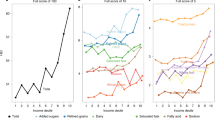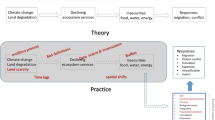Abstract
The purpose of this paper is to set forth a theoretical model of consumer decision-making in food desert regions, where healthy food is in short supply. Our model enables theoretical comparison of multiple policy approaches to mitigating food deserts that have heretofore been considered separately: taxing less healthy food, subsidizing healthier food, correcting misperceptions of the cost of food choices, and subsidizing creation of community and home gardens. This latter policy approach enables consumers to achieve higher rates of food security and health benefits, while strengthening the sustainability and resiliency of local urban ecological-economic systems.
Similar content being viewed by others
Notes
See, e.g., Kopelman (2007).
The U.S. Economic Research Service defines this distance as outside of one mile in urban areas and outside of 10 miles in rural areas (Economic Research Service 2013). Powell et al. (2007) find that poor and minority neighborhoods have fewer chain supermarkets. Moore and Diez Roux (2006) show that there are fewer fresh food and natural food stores, and fewer supermarkets, located in relatively poor neighborhoods. Schuetz et al. (2012, 282) suggest that it is an open question in the literature as to why retail stores are generally reluctant to locate in lower income neighborhoods. As they indicate, retail entrepreneurs may perceive higher operating costs in lower income neighborhoods that reduce expected profits.
See Barthel and Isendahl (2013).
See Clark et al. (2008).
References
Ali, M.M., Amialchuk, A., Renna, F.: Social network and weight misperception among adolescents. South. Econ. J. 77, 827–842 (2011)
Barthel, S., Isendahl, C.: Urban gardens, agriculture, and water management: sources of resilience for long-term food security in cities. Ecol. Econ. 86, 224–234 (2013)
Bedore, M.: Geographies of capital formation and rescaling: a historical–geographical approach to the food desert problem. Can. Geogr. 57, 133–153 (2013)
Berning, J.P., Chouinard, H.H., Manning, K.C., McCluskey, J.J., Sprott, D.E.: Identifying consumer preferences for nutrition information on grocery store shelf labels. Food Policy 35, 429–436 (2010)
Bitler, M., Haider, S.J.: An economic view of food deserts in the United States. J. Policy Anal. Manag. 30, 153–176 (2011)
Blumenthal, K., Volpp, K.G.: Enhancing the effectiveness of food labeling in restaurants. J. Am. Med. Assoc. 303, 553–554 (2010)
Bollinger, B., Leslie, P., Sorensen, A.: Calorie posting in chain restaurants. Am. Econ. J. Econ. Policy 3, 91–128 (2011)
Bowman, S.: Low economic status is associated with suboptimal intakes of nutritious foods by adults in the National Health and Nutrition Examination Survey 1999–2002. Nutr. Res. 27, 515–523 (2007)
Brown, K.H., Jameton, A.L.: Public health implications of urban agriculture. J. Public Health Policy 21, 20–39 (2000)
Chung, C., Myers, S.: Do the poor pay more for food? An analysis of grocery store availability and food price disparities. J. Consum. Aff. 33, 276–296 (1999)
Clark, H., Hausladen, D.M., Brabender, D.J.: Urban gardens: lead exposure, recontamination mechanisms and implications for remediation design. Environ. Res. 107, 312–319 (2008)
Colding, J., Barthel, S.: The potential of ‘urban green commons’ in the resilience building of cities. Ecol. Econ. 86, 156–166 (2013)
Curtis, F.: Eco-localism and sustainability. Ecol. Econ. 46, 83–102 (2003)
Donald, B.: Food retail and access after the crash: rethinking the food desert problem. J. Econ. Geogr. 13, 231–237 (2013)
Downs, J.S., Loewenstein, G., Wisdom, J.: Strategies for promoting healthier food choices. Am. Econ. Rev. Pap. Proc. 99, 159–164 (2009)
Economic Research Service: About the food access research atlas. United States Department of Agriculture. http://www.ers.usda.gov/data-products/food-access-research-atlas/about-the-atlas.aspx#.UZ3mS5x62So (2013). Accessed 13 Jan 2015
Finkelstein, E.A., Strombotne, K.L., Chan, N.L., Krieger, J.: Mandatory menu labeling in one fast-food chain in King County, Washington. Am. J. Prev. Med. 40, 122–127 (2011)
Hendrickson, D., Smith, C., Eikenberry, N.: Fruit and vegetable access in four low income food desert communities in Minnesota. Agric. Hum. Values 23, 371–383 (2006)
Jansson, Å.: Reaching for a sustainable resilient urban future using the lens of ecosystem services. Ecol. Econ. 86, 285–291 (2013)
Johansson-Stenman, O.: Mad cows, terrorism, and junk food: should public policy reflect perceived or objective risks? J. Health Econ. 27, 234–248 (2008)
Jones, E., Mustiful, B.: Purchasing behavior of higher- and lower-income shoppers: a look at breakfast cereals. Appl. Econ. 28, 131–137 (1996)
Kopelman, P.: Health risks associated with overweight and obesity. Obes. Rev. 8, 13–17 (2007)
Lagerkvist, C.J., Hess, S., Okello, J., Hansson, H., Karanja, N.: Food health risk perceptions among consumers, farmers, and traders of leafy vegetables in Nairobi. Food Policy 38, 92–104 (2013)
Lautenschlager, L., Smith, C.: Beliefs, knowledge, and values held by inner-city youth about gardening, nutrition, and cooking. Agric. Hum. Values 24, 245–258 (2007)
MacDonald, J.M., Nelson, P.E.: Do the poor still pay more? Food price variations in large metropolitan areas. J. Urban Econ. 30, 344–359 (1991)
Molaison, E.F., Connell, C.L., Stuff, J.E., Yadrick, M.K., Bogle, M.: Influences on fruit and vegetable consumption in low-income black American adolescents. J. Nutr. Educ. Behav. 37, 246–251 (2005)
Moore, L.V., Diez Roux, A.V.: Associations of neighborhood characteristics with the location and type of food stores. Am. J. Public Health 96, 325–331 (2006)
Petre, A., Wagner, J.: Green consumption under misperceived prices: an application to active transportation. South. Econ. J. 80, 187–204 (2013)
Powell, L.M., Slater, S., Mirtcheva, D., Bao, Y., Chaloupka, F.: Food store availability and neighborhood characteristics in the United States. Prev. Med. 44, 198–205 (2007)
Powell, L.M., Bao, Y.: Food prices, access to food outlets, and child weight. Econ. Hum. Biol. 7, 64–72 (2009)
Schuetz, J., Kolko, J., Meltzer, R.: Are poor neighborhoods ‘retail deserts’? Reg. Sci. Urban Econ. 42, 269–285 (2012)
Shankar, S., Klassen, A.: Influences on fruit and vegetable procurement and consumption among urban African-American public housing residents, and potential strategies for intervention. Fam. Econ. Nutr. Rev. 13, 34–46 (2001)
Shannon, J.: Food deserts: governing obesity in the neoliberal city. Prog. Hum. Geog. 38, 248–266 (2014)
Smith, T.G., Chouinard, H.H., Wandschneider, P.R.: Waiting for the invisible hand: novel products and the role of information in the modern market for food. Food Policy 36, 239–249 (2011)
Sundkvist, Å., Jansson, A., Larsson, P.: Strengths and limitations of localizing food production as a sustainability-building strategy—an analysis of bread production on the island of Gotland, Sweden. Ecol. Econ. 37, 217–227 (2001)
Thaler, R., Sunstein, C.: Nudge: Improving Decisions about Health, Wealth and Happiness. Yale UP, New Haven (2008)
Wagner, J.: On the economics of sustainability. Ecol. Econ. 57, 659–664 (2006)
Walker, R.E., Keane, C.R., Burke, J.G.: Disparities and access to healthy food in the U.S.: a review of food deserts literature. Health Place 16, 876–884 (2010)
Weatherspoon, D., Oehmke, J., Dembélé, A., Coleman, M., Satimanon, T., Weatherspoon, L.: Price and expenditure elasticities for fresh fruits in an urban food desert. Urban Stud. 50, 88–106 (2013)
Wrigley, N., Warm, D., Margetts, B., Whelan, A.: Assessing the impact of improved retail access on diet in a ‘food desert’: a preliminary report. Urban Stud. 39, 2061–2082 (2002)
Acknowledgments
We thank Editor Henk Folmer and two anonymous reviewers for several comments and suggestions that improved our paper. We also thank Professor Amit Batabyal; session participants at the 2013 New York State Economics Association annual meeting (particularly our discussant, Professor Wisdom Akpalu); and session participants at the 2014 Midwest Economics Association annual meeting (particularly our discussant, Roy Wada) for comments and suggestions on earlier drafts of this project.
Author information
Authors and Affiliations
Corresponding author
Rights and permissions
About this article
Cite this article
Hebda, C., Wagner, J. Nudging healthy food consumption and sustainability in food deserts. Lett Spat Resour Sci 9, 57–71 (2016). https://doi.org/10.1007/s12076-015-0138-2
Received:
Accepted:
Published:
Issue Date:
DOI: https://doi.org/10.1007/s12076-015-0138-2




